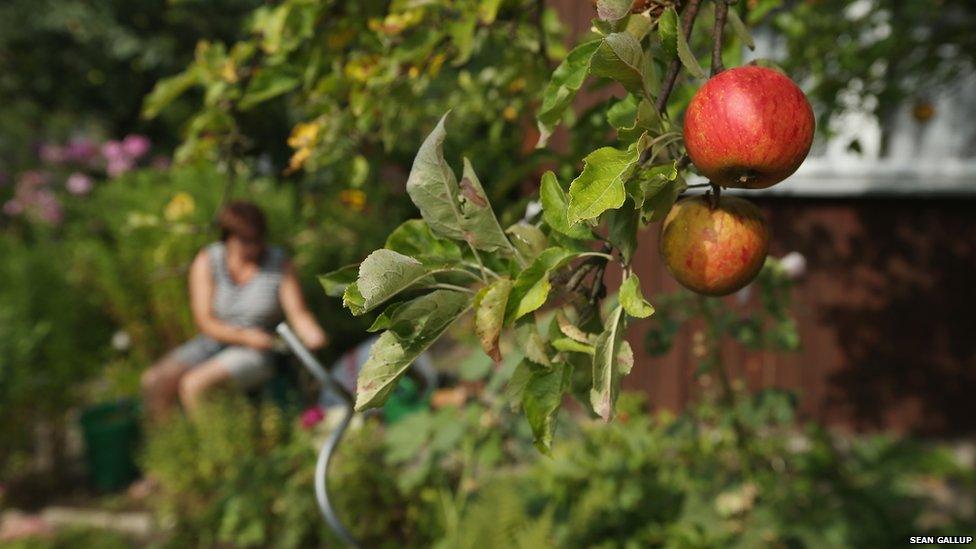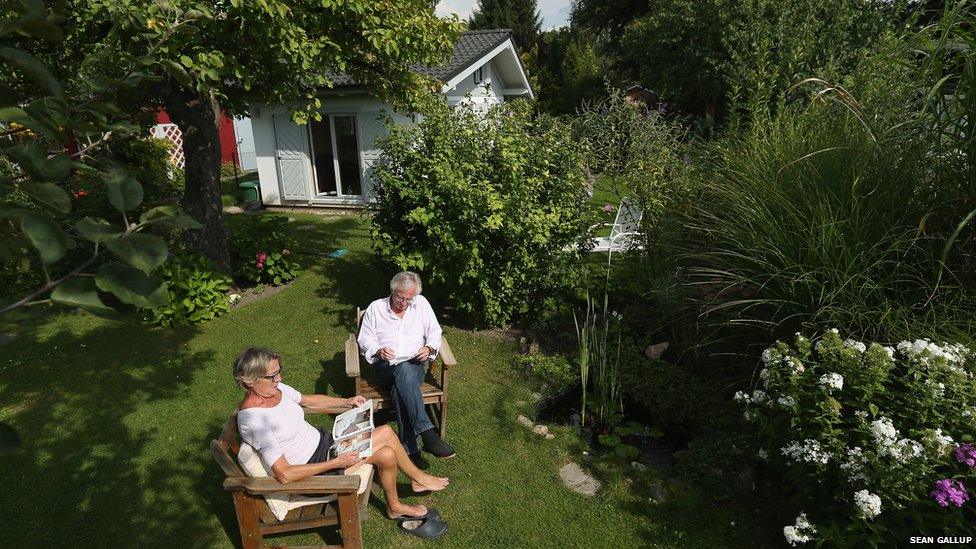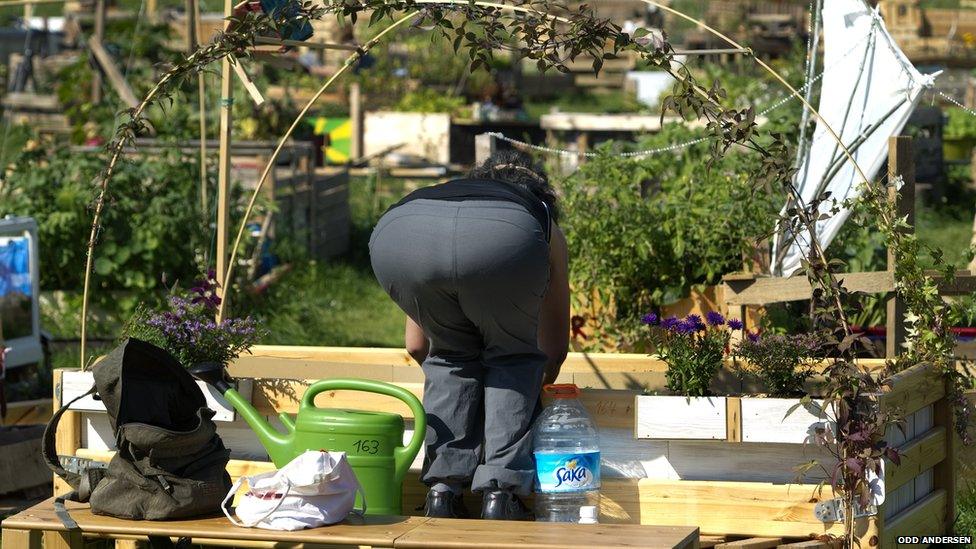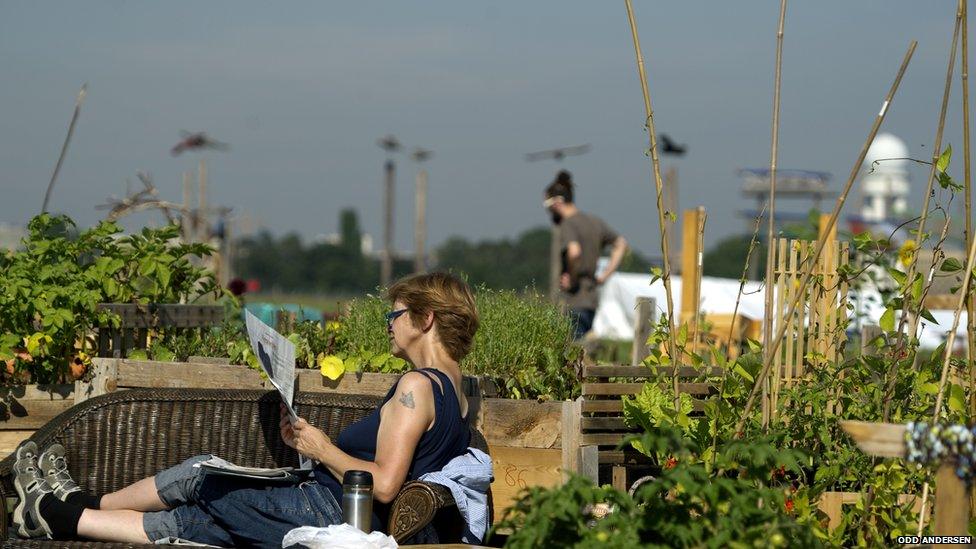Living the good life in Berlin's allotments - but for how long?
- Published

Forget the garden gnomes and replace those pink begonias with something more hip. Allotments in Germany are no longer the preserve of the pensioner, writes the BBC's Berlin correspondent, Damien McGuinness.
Fashionable Berliners are leaving the mainstream nightclubs to the tourists and heading to the countryside - or at least a few stops along the underground line - to get gardening.
Allotments have gone from tacky to trendy among forward-thinking urbanites looking for their own patch of nature.
For 25-year-old Carolina Achilles, who studied environmental studies and now works with refugees, having an allotment is a political statement and a form of protest against mass-produced food.
"I just think it's much nicer to eat what you can grow yourself," she says.

Pensioners are the mainstay of Germany's allotment culture but a younger generation is queuing up to take part.
She and her boyfriend rent a 280-sq m (3,000-sq ft) allotment for €400 (£290) a year, plus water and electricity costs. It comes with a 22-sq m house as well as apple, cherry and plum trees.
Although 90% of her neighbours are pensioners, she says increasing numbers of young people are moving in.


"For young families it's a way for children to experience nature, a safe place where they can play while still having everything the city has to offer," she says.
A demand for organically grown food in Berlin has also taken off over the past few years, she says, another reason why allotments are more popular.
"For me it's just a really nice place to invite guests over to party."

Gardeners have moved into Berlin's disused Tempelhof airport
In Germany there are about a million allotments, with the highest number by far - 70,000 - found in Berlin.
Originally they were set up during Germany's rapid industrialisation in the 19th Century to enable working-class children to stay in touch with nature. During two world wars they became an essential source of food for many.
They later fell out of fashion and until recently were seen as provincial, suffocating places of stuffy rules and bad taste. Hedges had to be a certain height, grass mowing was obligatory and painfully tended flower beds stuffed with garishly coloured gnomes and faux-rock ornaments were commonplace.
But now, as a new generation moves in, the only gnomes you see are ironic.
A booming birth rate in some parts of Berlin means that increasing numbers of young families, most of whom live in apartments, are looking for their own garden.
According to the German Leisure Garden federation, the average age of the allotment gardener hovers around 60 but over the past decade almost half of the new leases have been signed by young families. About half of Berlin's allotment associations have waiting lists.
It's one of the few places where people of different ages and backgrounds come together and mix socially, says 55-year-old graphic designer Oliver Becker, who has had a 400-sq m plot for five years.
"It's not just young hipsters. You get carpenters, factory workers, everyone," he says.

Demand for allotments has spread to Berlin's disused Tempelhof airport where small plots are springing up
But despite their popularity, the future of allotments is looking uncertain. Berlin's population is growing by about 80,000 people a year. With rents rising, there is growing pressure to build more housing and the authorities want to build on the allotments.
For some, allotments represent an indulgence for those wanting to selfishly fence off their own patch of paradise. For others they are the city's green lungs, a much-needed chance for ordinary working people to reconnect with nature.
Wandering round the cobbled lanes of one of Berlin's oldest allotment colonies, Bornholm II, one sunny weekday afternoon, the tiny curtained houses and toy-sized gardens made it feel like a Hobbits' village. Only the neighbouring tower blocks and the occasional plane approaching nearby Tegel airport remind you that you're in the centre of Germany's huge capital.
I met mothers with prams, dog walkers and joggers. None of them had allotments. But all lived in the apartment blocks nearby and came here regularly.
"I come here every day to walk the dog," says one middle-aged woman. "The gardeners often put out baskets of fruit and vegetables they don't need for passers-by. I give them a cake I've baked in return."
This allotment colony was set up in 1896 in the eastern Berlin district of Prenzlauer Berg — once a centre of red-brick factories and manual workers, and today a byword for gentrification.
Innovative
These allotments have survived the Nazis, the communists and, just a few hundred metres away, the Berlin Wall that once divided the city in two. But will they survive the property developers?
Roswitha Kierstein has been gardening here for more than 50 years, since she started coming to her parents' allotment at the age of four. Today she has the plot next door. With its wooden cottage and pretty fruit trees, it looks like something out of a fairytale.
But if Berlin's government has its way, within the next decade the diggers will knock down the cottage and tear up Roswitha's lawns and vegetable patches.
"It's all going to get built over," she said sadly with a resigned shrug.
"They just talk over our heads and ignore us," adds her husband angrily.
But other innovative forms of city gardening are also springing up.
For €60 a year anyone can rent a square metre at Himmelbeet, a project set up by a group of socially minded architects and town planners, for a spot of "urban gardening". There are gardening courses, cooking workshops and a summer open-air cafe amid the plots of growing vegetables.
A lot of the people there are environmentally minded 30-something Germans with young children. But the project's real aim is to help local underprivileged communities. Free workshops and social events are staged for lonely pensioners, newly arrived refugees, impoverished families or children with disabilities.
'Private happiness'
This is about gardening with a social mission - very different to traditional allotments, says the project's manager Felix Lodes, where the attraction is often privacy: fencing yourself in, and setting up your deckchair behind your own hedge.
"We look outwards not inwards," says Felix. "We aim for inclusion, rather than exclusion like allotments, where it's usually about finding your own private happiness."
Similar, more accessible pop-up allotments are springing up all over Berlin, including at the former Tempelhof airport where tomatoes and lettuces are now growing beside the runways.
In Kreuzberg, one of Berlin's more trendy areas, what had been a patch of wasteland for more than half a century has been cleared by neighbours and activists, and transformed into a stylish organic vegetable garden and a popular bar and cafe.
The non-profit company Nomadic Green, which runs Prinzessingarten, calls it mobile urban gardening.
Building sites, office rooftops and car parks are turned into pop-up farmland so that local people can grow their own food. It's about making the city greener and experimenting with new visions for urban sustainable living, say the organisers.